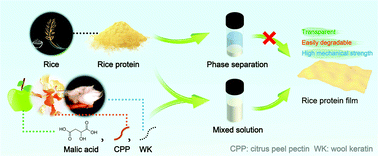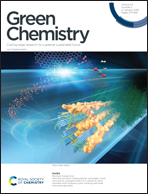Complete waste recycling strategies for improving the accessibility of rice protein films†
Abstract
Although a plant protein film is a promising alternative to petroleum-based plastic films, the insoluble nature of some plant proteins still limits their use as film-forming materials. Alkali and thermal treatments are traditional methods to produce films from proteins with low solubility, which might pose a risk of caustic burns and harmful substances. Three innovative strategies for the preparation of film-forming precursors were proposed in this study, namely, a new solvent system using malic acid, a resist folding structure modified by wool keratin, and an electrostatic bound structure by citrus peel pectin. Furthermore, we successfully prepared these three types of rice protein films using glycerin and thermal treatments. The results showed that the film prepared with malic acid has the lowest haze, opacity, and water vapor transmission ability, and the film containing wool keratin has the highest mechanical strength and water resistance. The addition of pectin provided more pronounced whiteness (p < 0.01) and rapid biodegradability compared with that for the film produced under conventional alkaline conditions. This work demonstrates facile preparation methods for safer and skin-friendly rice protein films and enlightens broad interests in the potential towards completely environment-friendly plant protein films as well.



 Please wait while we load your content...
Please wait while we load your content...